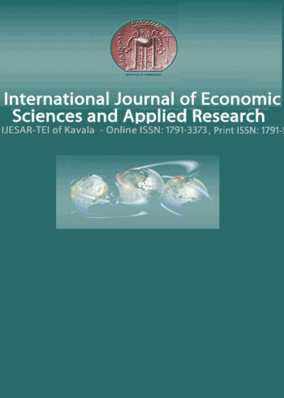A Country’s Process of Development as Described by a Butterfly Catastrophe Model : The Case of European South
Part of : International Journal of Business and Economic Sciences Applied Research ; Vol.6, No.2, 2013, pages 25-45
Issue:
Pages:
25-45
Abstract:
For a long period of time a country’s development has been synonymous with its economic growth. Over the last years, however, economies and societies have been undergoing dramatic changes. These changes have led to the concept of sustainable development, which refers to the ability of our societies to meet the needs of the present without sacrificing the ability of future generations to meet their own needs. Measuring sustainable development means going beyond a purely economic description of human activities; requires integration of economic, social and environmental concerns. New techniques are required in order to benchmark performance, highlight leaders and laggards on various aspects of development and facilitate efforts to identify best practices. New tools have to be designed so as to make sustainability decisionmaking more objective, systematic and rigorous. The majority of those methodologies make use of a single indicator in order to measure separately the evolution of each component i.e. the economic, the social and the environmental. Our objective in the present paper is to:oOutline the process of a country’s development taking into account all its three dimensions, economic, social and environmental.oPresent a model for quantifying its process of development encompassing all those dimensions.o Apply the model to European South countries.oDiscuss the results.
Subject:
Subject (LC):
Keywords:
country’s image, country’s process of development, economic social & environmental factors, butterfly catastrophe model
Notes:
JEL Classification: C65, Q01, R58
References (1):
- Aerts, D., Czachor, M., Gabora, L., Kuna, M., Posiewnik, A., Pykacz, J., Syty, M., 2003, ‘Quantum morphogenesis: a variation on Thom’s catastrophe theory’, Physical Review E, 67, pp. 1-13.Angelis, V. and Dimaki, K., 2011, ‘A Region’s Basic Image as a Measure of its Attractiveness’, International Journal of Economic Sciences and Applied Research, 4, 2, pp. 7-33.Angelis, V., Dimaki, K. and Tsetseri, M., 1999, ‘The environmental and the economicdimensions of sustainable development. The transition from conflict to Synthesis andthe Future Prospects’, Studies in Regional and Urban Planning, 7, pp. 29-40.Ashworth, C. J. and Voogd, H., 1990, Selling the City, Belhaven Press, London.Barbier, E. B., 1987, ‘The concept of sustainable economic development’, EnvironmentalConservation, 14, 2, pp. 101-110.Barrios, E. and Komoto, K., 2006, ‘Some approaches in the construction of a sustainable development index for the Philippines’, The International Journal of Sustainable Development and World Ecology 13, pp. 277-288.Beinat, E. and Nijkamp, P., 1998, Multicriteria Evaluation in Land-Use Management: Methodologies and Case Studies, Kluwer Academic Publishers, Dordrecht.Bell, M. L., Hobbs, B., Elliott, E. M., Ellis, H. and Robinson, Z., 2001, ‘An evaluation of multicriteria methods in integrated assessment of climate policy’, Journal of Multi-Criteria Decision Analysis, 10, 5, pp. 229-256.Berkes, F. and Folke, C., 1998, Linking Sociological and Ecological Systems for resilience and sustainability In Fikret Berkes and Carl Folke (eds.), Linking Sociological and Ecological Systems: Management practices and social mechanisms for buildingresilience, Cambridge University Press, New York.Bryson, J. R. and Daniels, P. W. (eds.), 2007, The Handbook of Service Industries, Edward Elgar, Cheltenham.Bramwell, B. and Rawding, L., 1996, ‘Tourism Marketing Images of Industrial Cities’, Annals of Tourism Research, 23, 1, pp. 201-221.Dallara, A. and Rizzi, P., 2013, ‘Geographic map of sustainability in Italian local systems’, Regional Studies 46, 1, pp. 321-337.Dichter, E., 1985, ‘What’s An Image’, The Journal of Consumer Marketing, 2, pp. 75-81.Dou, E. and Ghose, W., 2006, ‘A dynamic nonlinear model of online retail competition using cusp catastrophe theory’, Journal of Business Research, 59, pp. 838-848.Dowling, G. R., 1998, ‘Measuring Corporate Images: A Review of Alternative Approaches’, Journal of Business Research, 17, pp. 27-37.Du Pisani, J. A., 2006, ‘Sustainable development – historical roots of the concept’, Environmental Sciences, 3, 2, pp. 83-96.Gartner, W., 1993, ‘Image Formation Process’, Journal of Travel and Tourism Marketing, 2, pp. 191-215.Gilmore, R., 1993, Catastrophe Theory for scientists and engineers. Wiley, New York.Gunderson, L. H., Holling, C. S., Pritchard, L., Jr. and Garry D. Peterson, G.D., 2002.Resilience of Large-Scale Resource Systems, in Lance H. Gunderson and Lowell Pritchard, Jr. (eds), Resilience and the Behavior of Large-Scale Systems, Island Press, Washington, DC.Hayashi, K., 2000, ‘Multicriteria analysis for agriculture resource management: A critical survey and future perspectives’, European Journal of operational Research, 122, pp. 486-500.Huang, Y. K., 2008. ‘The study of customer segmentation examined by catastrophe model’, in Olya, M. and Uda, R. (eds) Towards Sustainable Society on Ubiquitous Networks, Springer, Boston, pp. 37-48.Janssen, R., 1992, Multiobjective decision support for environmental management, Kluwer Academic Publishers, Dordrecht.Janssen, R. and Munda, G., 1999, Multi-criteria methods for quantitative, qualitative and fuzzy evaluation problem, in J. van den Bergh (ed.), Handbook of Environmental and Resource Economics, Edward Elgar, Cheltenham, pp. 837-852.Karol, P. & Brunner, J., 2009, Tools for measuring progress towards sustainable neighborhood environments. Sustainability, 1, pp. 612-627.Kondakis, M., Dimaki, K. and Angelis, V., 2010, Selecting the Optimum Path of a Region’s Sustainable Development, 50th Congress of the European Regional Science Association, “Sustainable Regional Growth and Development in the Creative Knowledge Economy”, 19-23 August, Jönköping, SwedenKotler, P., Haider, D. H., Irving, R., 1993, Marketing Places: Attracting Investment,Industry and Tourism to Cities, States and Nations, Free Press, New York.Kotler, P., Asplund, C., Rein, I., Haider, D. H., 1999, Marketing Places Europe, PrenticeHall, London.Martinez-Alier, J., Munda, G. and O΄Neill, J., 1998, ‘Weak comparability of values as afoundation for ecological economics’, Ecological Economics, 26, pp. 277-286.Martinez-Alier, J., Munda, G. and O΄Neill, J., 2001, Theories and methods in ecologicaleconomics: A tentative classification, in C. J. Cleveland, Stern, D. J. and Costanza,R., (eds), The Economics of Nature and the Nature of Economics, Edward Elgar,Cheltenham, pp. 34-56.Mill, J. S., 1883, Principles of political economy, with some of their applications to socialphilosophy, People’s edition, London, Longmans Green.Munda, G., 1995, Multicriteria Evaluation in a Fuzzy Environment –Theory andApplications in Ecological Economics, Contributions to Economics Series, Physica -Verlag, Heidelberg.Munda, G., 2005, Multiple Criteria Decision Analysis and Sustainable Development, in J.Figueira, S. Greco and M. Ehrgott (eds), Multiple Criteria Decision Analysis: State ofthe Art Surveys, Springer Verlag, Boston, Dordrecht, London, pp. 953-986.Munda , G., 2006, ‘Social multi-criteria evaluation for urban sustainability policies’, LandUse Policy, 23, pp. 86-94.Munda, G., 2008, Social multi-criteria Evaluation for a Sustainable Economy, Springer-Verlag, Heidelberg.Munda G. and Nardo M., 2005, Construction Consistent Composite Indicators: the Issue of Weights, EUR 21834 EN, Joint Research Centre, Ispra, Italy.Munda G. and Nardo M., 2009, ‘Non-compensatory/Non-Linear composite indicators forranking countries: a defensible setting’, Applied Economics, 41, pp. 1513-1523.Munda, G., Paruccini, M. and Rossi, G., 1998, Multicriteria evaluation methods inrenewable resource management: The case of integrated water management underdrought conditions. In E. Beinat and P. Nijkamp (eds), Multicriteria Evaluation in Land-Use Management: Methodologies and Case Studies, Kluwer Academic Publishers,Dordrecht, pp. 79-94.Nijkamp, P., Rietveld, P. and Voogd, H., 1990, Multicriteria Evaluation in PhysicalPlanning, North-Holland, Amsterdam.O΄Neill, J., 1993, Ecology, Policy and Politics, Routledge, London, 1994.Pendall, R., Foster, K. A. and Cowell, M., 2010, ‘Resilience and regions: buildingunderstanding of the metaphor’, Cambridge Journal of Regions, Economy and Society,3 (1), pp. 71-84.Poston, T. and Stewart, I., 1996, Catastrophe Theory and its Applications, Dover, NewYork.Ringius, L., Asbjorn, T. and Holtsmark, B., 1998, ‘Can multi-criteria rules fairly distributeclimate burdens? OECD results from three burden sharing rules’, Energy Policy, 26, 10,pp. 777-793.Romero, C. and Rehman, T., 1989, Multiple Criteria Analysis for Agricultural Decisions,Elsevier, Amsterdam.Rosser, J. B., 2007, ‘The rise and fall of catastrophe theory applications in economics: Was the baby thrown out with bathwater?’, Journal of Economic Dynamics and Control, 10,pp. 3255-3280.Saisana, M. and S. Tarantola, S., 2002, State-of-the-art report on current ethodologies and practices for composite indicator development. EUR 20408 EN, European ommission, JRC, Ispra, Italy.Shen, L.-Y., Jorge Ochoa, J. Shah, M.N. and Zhang, X., 2011, ‘The application ofsustainability indicators – A comparison between various practices’, HabitatInternational 35, 1, pp. 17-29.Singh, R. K., Murty, H. R., Gupta, S. K. & Dikshit, A. K., 2009, ‘An overview ofsustainability assessment methodologies’, Ecological Indicators, 9, pp. 189-212.Smerz, K. E. and Guastello, S. J., 2008, ‘Cusp catastrophe model for binge drinking incollege population’, Nonlinear Dynamics, Psychology and Life Sciences, 12, pp. 205-224.Smith, M., Lancioni, R. A., Oliva, T. A., 2005, ‘The effects of management inertia on thesupply chain performance of produce-to stock firms’, Industrial Marketing Management,24, pp. 614-628.Solow, R., 1991, Sustainability: An Economist’s Perspective, Lecture to the Marine PolicyCentre, Massachusetts.Thom, R., 1975, Structural Stability and Morphogenesis: An Outline of a General Theoryof Models. Addison-Wesley, Reading M.A.Van der Mass, H. L. J., Kolsteib, R., Van der Pligt, J., 2003, ‘Sudden transitions in attitudes’, Sociological Methods and Research, 32, pp. 395-417.Wales, D. J., 2001, ‘A microscopic basis for the global appearance of energy landscapes’, Science, 293, pp. 602-604.Yigitcanlar, T. & Dur, F., 2010, ‘Developing a Sustainability Assessment Model: TheSustainable Infrastructure, Land-Use, Environment and Transport Model’, Sustainability,2, pp. 321-340Zeeman, E. C., 1973, ‘Applications of Catastrophe Theory’, International Conference onManifolds, Tokyo, Japan, pp. 11-26.




